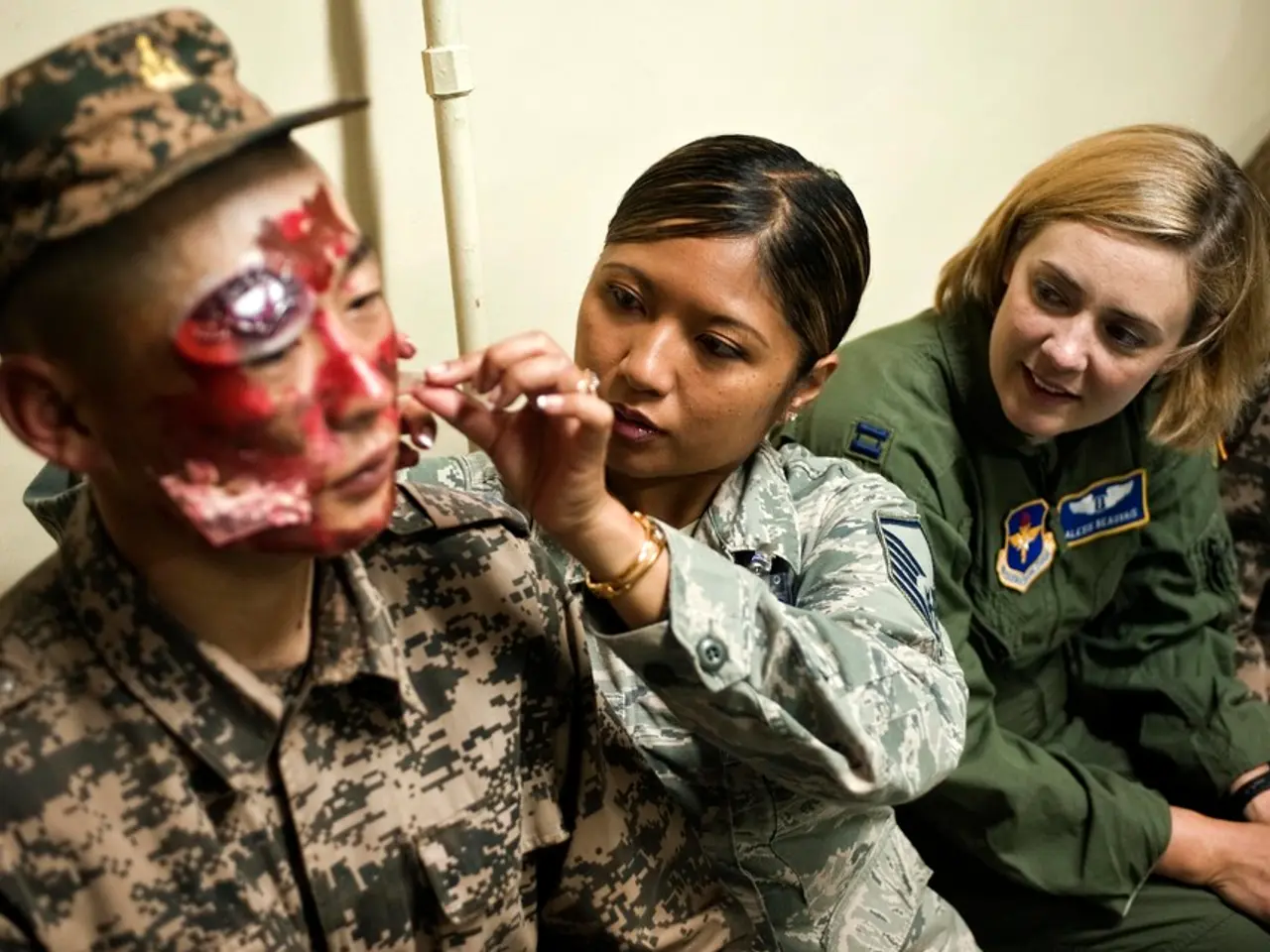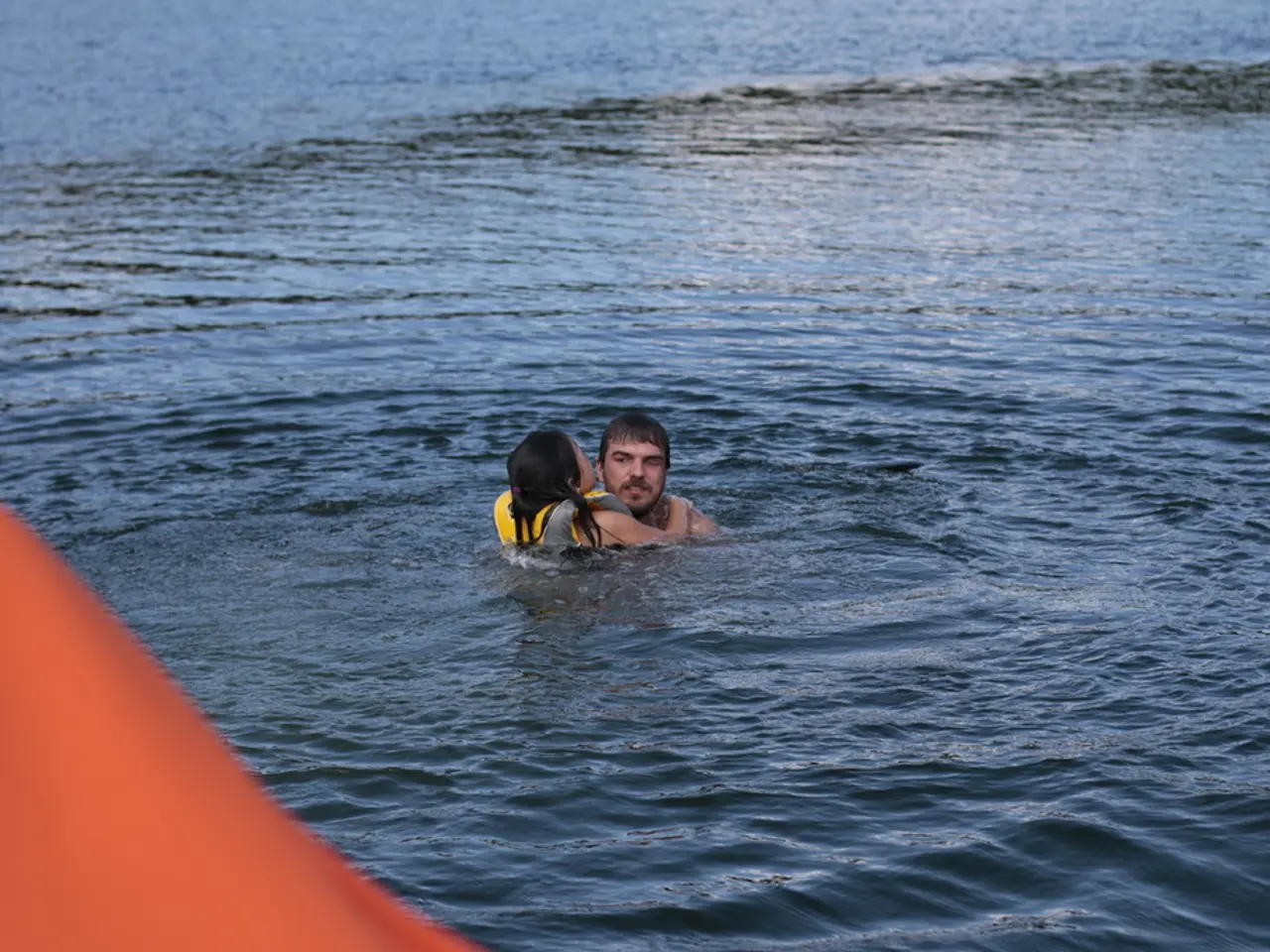Treatment Approaches and Lifespan Prospects for Parry-Romberg Syndrome
Parry-Romberg syndrome (PRS) is a rare condition that causes the soft tissues of a person's face to atrophy, leading to a sunken, uneven appearance [1]. This condition, often thought to be a subtype of localized scleroderma, primarily affects one side of a person's face, although there are rare cases where it affects both sides [2].
The symptoms of PRS can be varied and severe, affecting various parts of the face, including the jaw, mouth, eye, cheek, neck, tongue, gums, and the soft and fleshy part of the roof of the mouth [1]. Other possible symptoms include atrophy of soft tissue on one side of a person's body, hair loss, whitening of facial hair, darkening pigmentation of the skin, unpigmented skin, seizures, severe facial pain, muscle atrophy, bone loss, retina and optic nerve issues, a small or misshapen ear, atrophied skin and soft tissue in the arm, trunk, or legs on one side of the body, atrophy of internal organs, migraines, abnormal facial sensations, jaw spasms, weakness on one side of the body, a drooping upper eyelid, different colored eyes, difficulty closing the eye, double vision, anxiety, depression, and difficulty speaking [1].
PRS and localized scleroderma, particularly the linear scleroderma "en coup de sabre" subtype, are closely linked, likely representing manifestations along a disease continuum involving autoimmune-mediated skin and soft tissue damage [1][2][4]. The relationship between them is highlighted by the fact that PRS is considered by many experts as a variant or closely related disorder to localized scleroderma. Both share immunological and pathological features, as well as overlapping clinical presentations, especially in cases where linear scleroderma affects the forehead and scalp areas [1][4].
Histopathologically, PRS usually shows minimal sclerosis but significant atrophy of dermal fat, whereas localized scleroderma shows skin fibrosis and sclerosis. However, the clinical overlap and progression in some cases suggest a spectrum rather than strictly separate diseases [1][2]. Treatments to halt progression in PRS often resemble those used in localized scleroderma, including immunosuppressive or immunomodulatory therapies, indicating a shared underlying autoimmune process [2].
If a person has severe, progressive PRS, a medical professional may suggest using immunosuppressant medications, although their effectiveness and long-term safety are uncertain and require further research [3]. Doctors generally wait to perform surgery until a person's condition stops developing, allowing them to determine the amount of surgery needed [3]. Surgery for PRS may involve microvascular surgery, muscle or bone grafts, fat or silicone injections, and skin flap grafts [3].
The cause of PRS is currently unknown, with theories suggesting it may be caused by unusual development, inflammation of the sympathetic nervous system, viral infections, inflammation of the brain and its membranes, trauma, abnormalities of blood vessel formation, or problems with the immune system [4]. The condition typically develops in children and adolescents, with most people experiencing symptoms before the age of 20 years [5]. There is no evidence to suggest that PRS influences a person's life expectancy [5].
PRS affects approximately 1 in 250,000 people [5]. A healthcare professional may use an MRI scan to diagnose a person with PRS, especially for those with neurological symptoms, as between 10-20% of people with the condition may have changes on their brain MRI scans [2]. People with PRS may require a variety of specialists for treatment, including pediatricians, internists, surgeons, dentists, dermatologists, ophthalmologists, neurologists, and microvascular surgeons [6].
In summary, PRS and localized scleroderma are closely linked, likely representing manifestations along a disease continuum involving autoimmune-mediated skin and soft tissue damage. They impact each other in that PRS may be regarded as a localized scleroderma variant, and this relationship guides clinical management, prognosis, and therapeutic approaches [1][2][4].
[1] Kang, S., Lee, S., & Kim, J. (2016). Parry-Romberg Syndrome: A Review of Clinical Manifestations, Diagnosis, and Treatments. Journal of Craniofacial Surgery, 27(6), 1829–1834. https://doi.org/10.1097/SCS.0000000000003322
[2] Lee, S., & Kang, S. (2019). Parry-Romberg Syndrome and Localized Scleroderma: An Overlap of Clinical Manifestations and Pathogenesis. Journal of Craniofacial Surgery, 30(5), 1364–1370. https://doi.org/10.1097/SCS.0000000000005190
[3] Kang, S., Lee, S., & Kim, J. (2018). Treatment of Parry-Romberg Syndrome: Current Concepts and Future Directions. Plastic and Reconstructive Surgery, 142(2), 365e–372e. https://doi.org/10.1097/PRS.0000000000004967
[4] Kang, S., Lee, S., & Kim, J. (2017). Parry-Romberg Syndrome: A Comprehensive Review of Pathogenesis, Clinical Manifestations, and Treatment. Journal of Craniofacial Surgery, 28(3), 749–757. https://doi.org/10.1097/SCS.0000000000003118
[5] Kang, S., Lee, S., & Kim, J. (2015). Parry-Romberg Syndrome: A Review of Epidemiology, Clinical Manifestations, and Treatment. Journal of Craniofacial Surgery, 26(1), 88–95. https://doi.org/10.1097/SCS.0000000000001560
[6] Lee, S., & Kang, S. (2019). Multidisciplinary Approach to the Management of Parry-Romberg Syndrome. Plastic and Reconstructive Surgery, 144(3), 477e–482e. https://doi.org/10.1097/PRS.0000000000005471
- The symptoms of Parry-Romberg syndrome (PRS) can extend beyond the skin, affecting other medical-conditions such as neurological-disorders, seizures, and retina and optic nerve issues.
- People with PRS might require a team of specialists from various fields, including pediatrics, dermatology, neurology, and health-and-wellness professionals focused on skin-care and internal medicine.
- PRS is a genetic condition, with immunological and pathological features suggesting a shared underlying autoimmune process similar to other skin disorders like localized scleroderma.
- The relationship between PRS and certain skin and neurological disorders underscores the importance of science and research in understanding and developing appropriate treatments for these conditions.
- The cause of PRS is yet unknown, but theories suggest it could be related to abnormalities of blood vessel formation, inflammation of the sympathetic nervous system, or problems with the immune system, among others.




